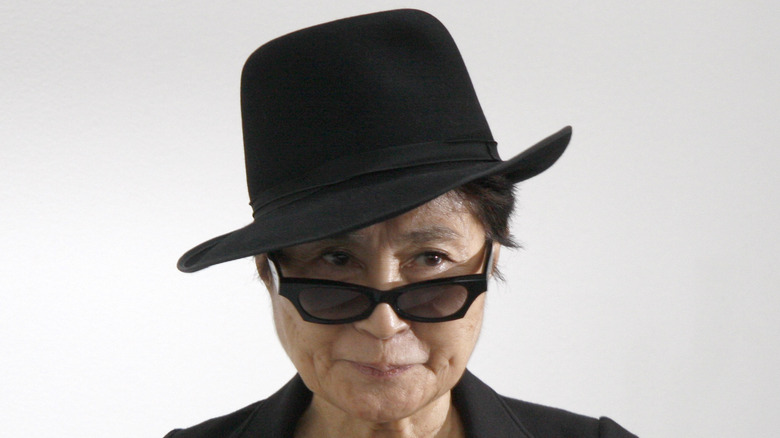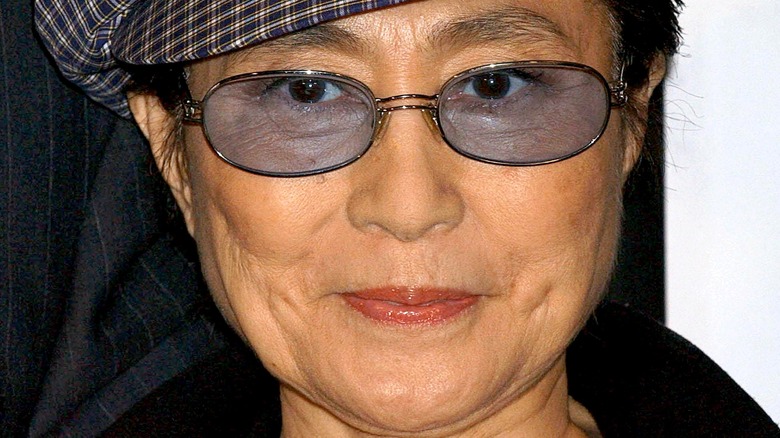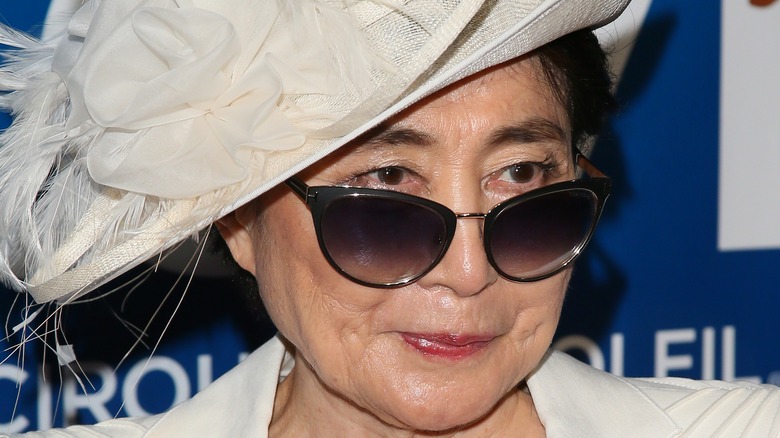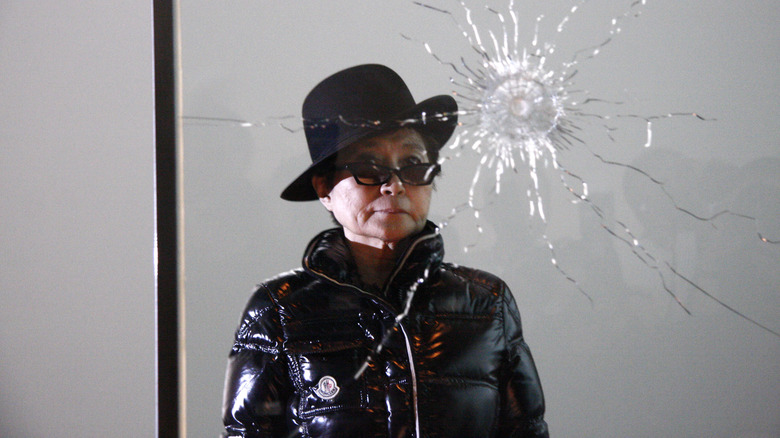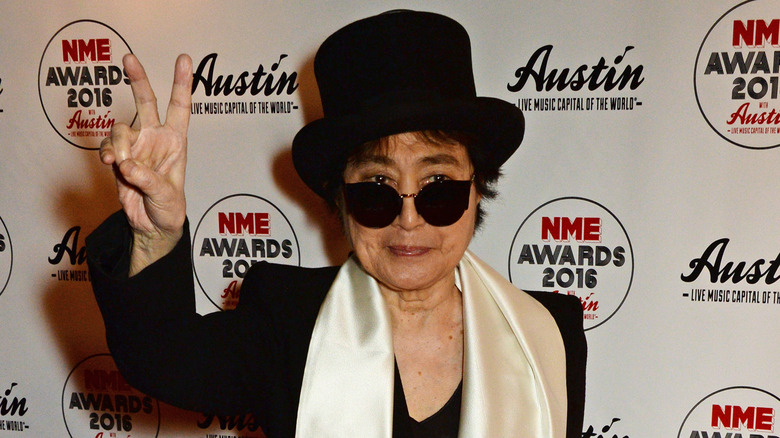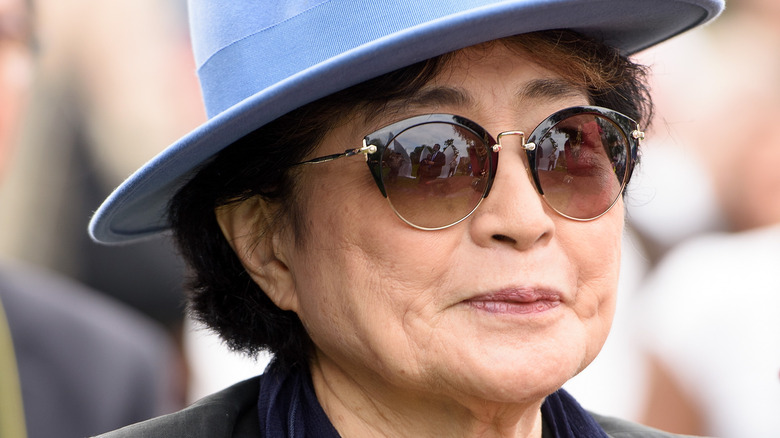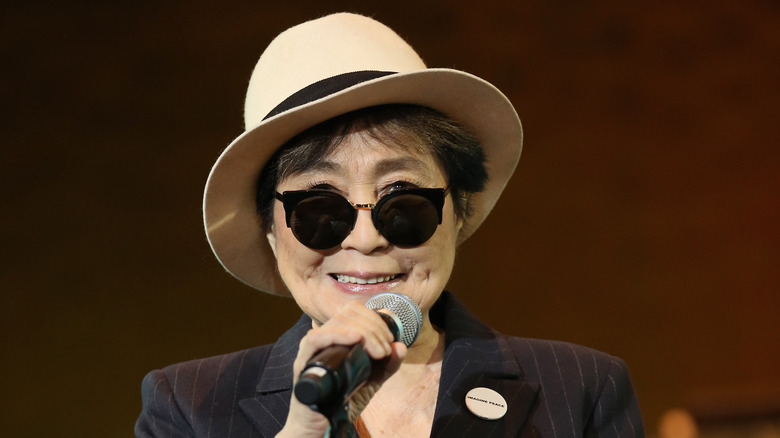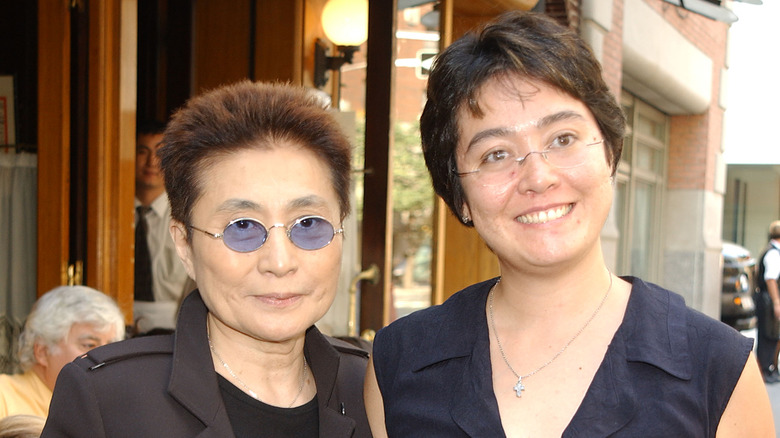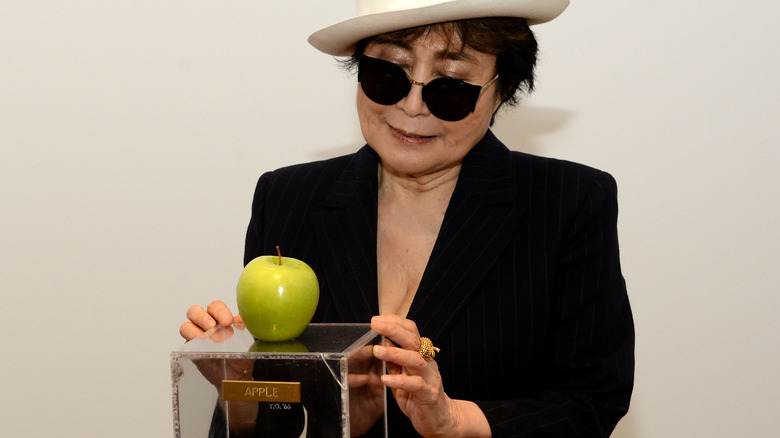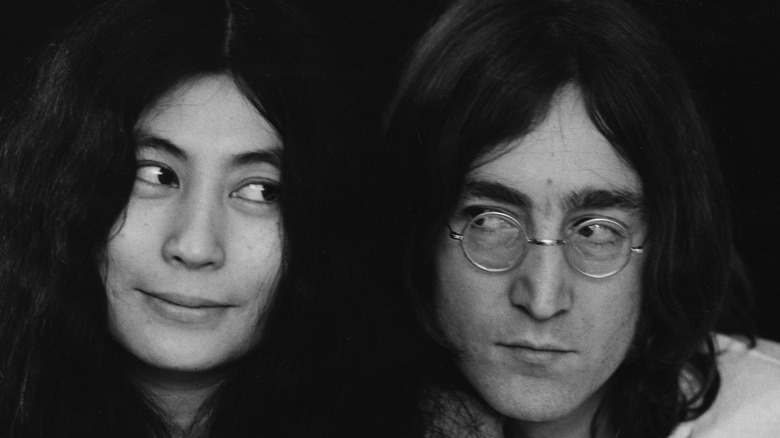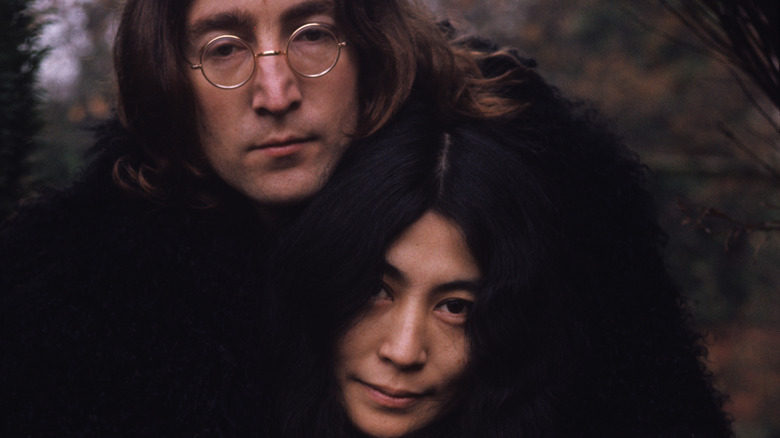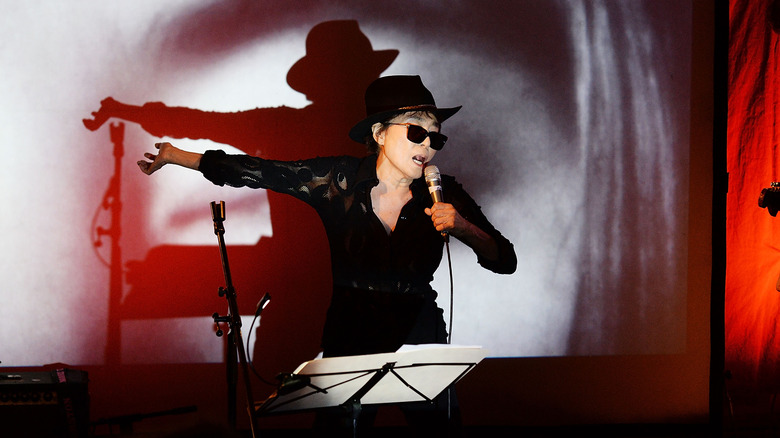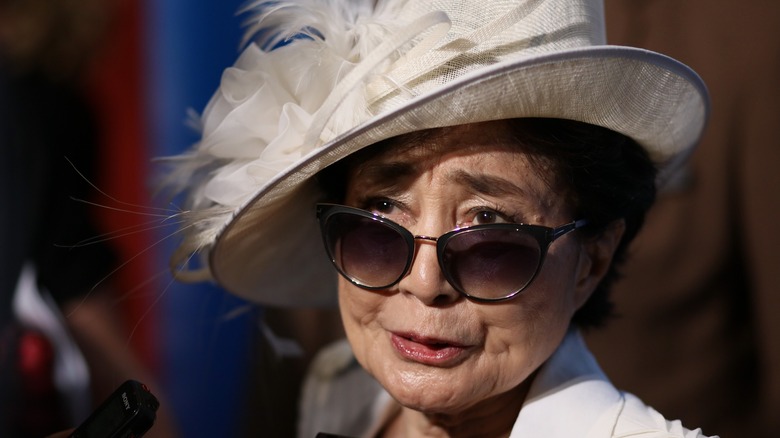The Untold Truth Of Yoko Ono
Yoko Ono is an intriguing public figure who has received plenty of love, admiration, criticism over the years. She first received mainstream attention when she tied the knot with the Beatles' beloved frontman, John Lennon (via Biography.) As a result of the marriage, Ono had to deal with plenty of media attention for several years.
She is many things at once: an artist, a musician, a performer, a dreamer, and more. One of her most notable characteristics is that she's original and doesn't hesitate to walk away from conventional things even if she has to deal with criticism for her unconventional music, performance art, and other artistic ventures.
Ono is unusual in more ways than one. She told Interview Magazine that she doesn't even think that she is strictly an artist, saying, "I don't particularly consider myself just an artist. I'm a woman — I'm a human being — and there are a lot of situations that covers." She also spoke about how she's perceived by the public, and how she learned to deal with difficult situations after Lennon's death. She explained,"...I was kind of alone. I wasn't valued by people ... and I kind of like myself for being the one who survived regardless."
There's more to Yoko Ono than her marriage to John Lennon and her polarizing art. This is the untold truth of Yoko Ono.
Yoko Ono didn't have a great childhood
Yoko Ono belongs to a distinguished Japanese family. She was born on February 18, 1933 in Tokyo, Japan. According to Biography, she has two younger siblings and spent time in the United States as a child on account of her father's work as a banker. Despite being privileged, Ono didn't have a great childhood. Per Clash, she felt that she didn't receive much love or attention in her early years.
She remembered her father as a free-spirited man who loved music and playing the piano. But he couldn't devote much time to Ono, and when a young Ono expressed her desire to play the piano, her father discouraged her by saying that she had tiny hands. She shot back that she'd rather be a composer, and he said that this didn't seem probable considering that there were hardly any popular female composers at the time. She didn't get discouraged, and continued focusing on the things that interested her. Also, as highlighted by Vulture, Ono's mom was a harsh critic who didn't have kind things to say about her daughter's looks.
Yoko Ono's family suffered during the war
Things got turned upside down for Yoko Ono and her family during World War II. According to Vulture, the war created a physical divide between her family members. Things got especially nasty when Ono, her mom, and her siblings had to seek shelter in a bunker after the 1945 bombings in Tokyo. With food shortages, they had to barter for something to eat, and sometimes went hungry. According to the Rolling Stone, Ono and her family knew people who starved or died after trying to consume poisonous mushrooms during the war. She later said, "I remember being hungry and I know it's so difficult to just be hungry." When she didn't have anything to eat, she told other children around her that she simply wasn't hungry.
Meanwhile, Ono's dad was captured as a prisoner of war and his family had no idea where he was for nearly a year. Even after the conflict ended, Ono felt confused by the cultural context. She said, "I remember being in film theaters where the baddies were always Asian. When the lights went up, I thought, 'Am I [a baddie too]?'"
Yoko Ono has always been unconventional
Yoko Ono was different from the beginning, and she doesn't hesitate to own up to it. She was the first woman to enrol in the philosophy program at Gakushuin University (via Hello Giggles.) However, she didn't finish her studies there, moving to Sarah Lawrence College in New York. According to Biography, Ono didn't finish this program either and eloped with her lover instead.
Ono was heavily drawn to the arts and did her best to learn as much as possible. Her first mentor was renowned artist La Monte Young. But Ono's early work wasn't accepted by the public, with some seeing it as too progressive. Even as a child, Ono didn't receive praise for her efforts (via "Yoko Ono: Collector of Skies" by Nell Beram.) When she mentioned that she'd like to pursue writing, her teachers told her that her work was "hard to categorize."
Per Stanford News, Ono especially liked instructional art, and came up with "Painting to Be Stepped On." The premise of this piece was exactly what it sounds like: those who walked past the empty painting were allowed to step on it.
Yoko Ono felt like she didn't belong
As highlighted in the book, "Yoko Ono: Collector of Skies," Yoko Ono was pretty different from her classmates in school. For one, she didn't mind asking questions and being outspoken. Japanese society in general expected kids to be obedient in front of their elders. Ono was probably somewhat influenced by the time she spent in the U.S. as a child, where she was exposed to a different way of living. However, this didn't do much for her popularity. Ono is quoted as saying, "I was terribly lonely. At school ... I didn't have any friends."
At one point, Ono's mom decided to send her to a rural school, where she and her sibling were subjected to bullying for being city kids. Her sibling dropped out, but Ono stayed resilient, showing up for her classes every day.
Even later in life, when she was living in New York, she felt like she was too different from the rest of her family. At the same time, she reports going through a transition that allowed her to accept that being different wasn't really "a bad thing" and that it was OK to be herself.
Yoko Ono decided to follow her heart
Yoko Ono has never been afraid to take risks in life. She left college after she met her first husband, composer Toshi Ichiyanagi. According to the Los Angeles Times, the two were both trying to make a mark in the art scene in New York in the 1950s. Ono's parents weren't comfortable with the relationship on account of the fact that Ichiyanagi came from a less privileged background. According to "Yoko Ono: Collector of Skies," Ono tried to convince her parents of his worth but she wasn't successful. In fact, they told her that they would disown her if she stayed with her lover.
Ono didn't listen to them, and decided to take a leap of faith. She eloped with Ichiyanagi in 1956. Ono recalls life with her husband in New York, finding comfort in the city's busy atmosphere and saying, "I was living next to a meat market and I felt as if I had a house with a delicatessen in it."
Yoko Ono has faced mental health struggles
According to Stanford News, Yoko Ono tried to take her own life in the 1960s. She was struggling and felt like her work wasn't getting the attention it deserved. Her worried family members sent her to a mental health clinic, where they hoped she would be able to recover. Per "Yoko Ono: Collector of Skies," she was feeling far too overwhelmed at the time and wasn't sure how to cope with her feelings. She later said, "There was much emotional turmoil in my life ... and I felt depressed. At that point, being taken care of in any form seemed a glorious option."
At the clinic, she was visited by jazz musician Anthony Cox, a man who somehow knew exactly how to help her feel better about herself. The two kept in touch after Ono left the clinic. Eventually, Ono fell in love with Cox and they later married. Ono and her first husband, Toshi Ichiyanagi, remained friends despite their divorce.
If you or someone you know is struggling with mental health, please contact the Crisis Text Line by texting HOME to 741741, call the National Alliance on Mental Illness helpline at 1-800-950-NAMI (6264), or visit the National Institute of Mental Health website.
Yoko Ono was estranged from her only daughter for decades
According to Biography, Yoko Ono and Anthony Cox divorced in 1962. Their separation turned rather ugly and Cox ended up going off the grid with their daughter, Kyoko. According to the Guardian, Ono didn't see her only daughter for many years, from when Kyoko was 8 to when she was 31.
When Ono was married to John Lennon, the two of them made efforts to find Kyoko, reportedly traveling "from America to England, Denmark, and Spain" before suing for custody in the U.S. Virgin Islands, where Ono and Cox's divorce had been filed (per AmoMama). Ono and Lennon won custody, but Cox took the child to the Texas, before vanishing completely for some time.
Per Associated Press, in the 1980s Ono penned a heartfelt open letter to her child, writing, ″All these years there has not been one day I have not missed you. You are always in my heart. However, I will not make any attempt to find you now as I wish to respect your privacy." Ono further added that she would love to hear from Kyoto and that she loved her very much. Ono wrote, "...you should not feel guilty if you choose not to reach me. You have my respect, love and support forever.″
Ono and Kyoko finally reunited in 1997, and Kyoko was introduced to her half-sibling, Sean Lennon. Kyoko was married with a child, making Ono a grandmother. Today, the mother and daughter reportedly remain in regular contact.
It took some time for Yoko Ono's music to make an impression
While Yoko Ono had been passionate about music for a very long time, it took a long time for her to get any kind of attention for her work. For many years, her performance art and unconventional musical style was subject to "mockery, incomprehension and even rage," as described by the Guardian.
But, according to another article by the Guardian, she was fairly confident about her work despite not receiving much validation. She particularly enjoyed working with her late husband, John Lennon, and feels grateful whenever anyone pays a tribute to the songs she created with the Beatles' frontman. Ono said, "The first albums I made with John, 'Two Virgins' and 'Life With the Lions,' we called them 'Unfinished Music,' and I think that idea has developed into something: you have a certain artistic attempt and then you openly involve other people."
Over the years, Ono experimented with her work and tried more conventional forms of music too. She noticed that many people didn't hesitate to use harsh words while speaking about her songs. She said that fortunately, she didn't get affected because her dad was such a strict musician himself. In later years, Ono's music found a fan following of its own and she has worked with mainstream artists like Lady Gaga. In response, Ono simply said, "It's my arrogance, but I thought it [her music] was beautiful all along."
Yoko Ono is disturbed by some public allegations
For some, Yoko Ono is best known for breaking up the Beatles. Although this isn't true, and the real causes were much more complicated, Ono took the brunt of it from some Beatles fans. According to Today, Ono found these accusations rather disturbing."It feels like I was accused of something that I didn't do, which was breaking up the Beatles," Ono said. "That was like being somebody who is in prison without having done anything wrong." (via Interview Magazine.)
Ono has said that she handled the negativity by learning to embrace self compassion, saying "I started to feel that if no one else loved me, then I had to love myself." As time went by, Ono also managed to mend her relationship with the Beatles. In fact, Paul McCartney has praised her, telling Rolling Stone that "She's a badass. I thought, 'If John loved her, there's got to be something. He's not stupid.'"
Yoko Ono experienced several miscarriages
Per the New Yorker, Yoko Ono lived through several miscarriages. According to an Uncut piece, one of these experiences inspired the John Lennon and Yoko Ono album "Life With the Lions."
In the late 1960s, Ono had been taken to the hospital due to a possible miscarriage. Her husband stayed by her side and made music, expressing his feelings through the songs that he wrote. These tunes went on to become "Life With the Lions." The pregnancy ended in miscarriage, and the couple ensured that their son, John Ono Lennon II had a private burial. Around this time, Lennon plead guilty to possession of cannabis — although the couple said that the drugs were planted — and his solicitor argued that the stress of the police raid had contributed to Ono's miscarriage.
In 1975, at the age of 42 and after three miscarriages, Ono gave birth to Sean Lennon. "I feel higher than the Empire State Building," Lennon stated, expressing his joy at the birth of his second son.
Performance art is an old passion for Yoko Ono
Yoko Ono loves art of every kind. As far as she is concerned, art is a thing of beauty, something that is always meant to be admired and revered. But her own work has been difficult to digest for some. A lifelong performer and an avant-garde artist, Ono's work has often elicited strong reactions. For example, one of her most well-known pieces was a performance called "Cut Piece," in which audience members were asked to cut off parts of Ono's clothing (via Vulture.) The performer remained stoic and calm throughout the process.
"Cut Piece" made its debut in the 1960s and was so infuriating for a visitor in Kyoto, Japan that he almost attacked Ono with a pair of scissors. Meanwhile, when the piece was performed by another artist in a convent setting, the audience members were moved and embraced the action in a much more forgiving manner. Ono said, "they bypassed the sexual connotation totally and just understood the philosophical connotation and the positive side, which was to be giving."
Per the Conversation, Ono's work is meaningful and often a strong response to violence. Ono explained, "I like to fight the establishment by using methods that are so removed from establishment-type thinking that the establishment does not know how to fight back."
Yoko Ono has experienced health troubles
Perhaps unsurprisingly, Yoko Ono isn't as strong as she used to be. Now in her late 80s, she needs more support, and, according to Cheatsheet, there have been some reports that she requires constant care at home. The artist and musician has also been spotted using a wheelchair on several occasions in recent years.
She doesn't open much about her health, but at an awards ceremony in 2017, Ono said, "Thank you, thank you, thank you, I've learned so much from having this illness. I'm thankful I went through that." However, she didn't share more details of what illness she suffers from. Some have speculated that she had a stroke, but in 2016, her son dismissed that report via Twitter.
In 2020, Elliot Mintz, a friend of Ono's who acts as her spokesperson, said that the artist's spirit remained as lively as ever. "She has definitely slowed down, like anyone at that age. But she is as sharp as she once was."
